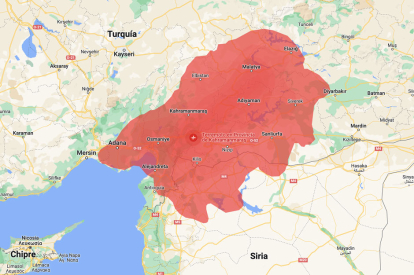Turkey and Syria suffer worst catastrophe in four decades
Local authorities are already reporting more than 6,000 dead and around 30,000 injured in the largest magnitude earthquakes in 40 years.

Terremoto en Turquía / Cordon Press.
Two earthquakes measuring 7.8 and 7.6 on the Richter scale in Turkey and Syria have left more than 6,000 dead and around 30,000 injured, according to reports from local authorities in both countries. In addition, hundreds of people are still missing under the rubble or remain unaccounted for, so the true number of victims looks increasingly likely to rise as the hours go by.
In the early hours of Monday morning (local time), a 7.8 magnitude earthquake devastated the central and southern regions of Turkey and northwestern Syria. The origin or "hypocenter" was estimated to be located at a depth of about 10.5 miles. Due to weak foundations, many buildings collapsed and the earthquake caused chaos in the streets.

Area affected by the earthquake / Google Maps.
The Syrian government reported that the main cities affected were Latakia, Hama, Aleppo and Tartus. The regime of Bashar al-Assad launched a national emergency plan to coordinate rescue operations and establish dialogue with the international community.
Meanwhile in Turkey, President Erdogan reported that the earthquake originated in the cities of Pazarcik and Gaziantep, he also confirmed that he has already started receiving aid from a multitude of countries.
Hours later, a second earthquake measuring 7.6 on the Richter scale struck again, this time in southeastern Turkey. The epicenter of this earthquake was in the town of Elbistan. Aftershocks were felt in several countries, including Cyprus, where another earthquake of magnitude 4.5 was recorded.
The devastating fault in eastern Anatolia
The earthquakes originated around the East Anatolian fault. This geological structure, known as a a strike-slip fault, is made up by Anatolian and Eurasian tectonic plates that are pushing up against each other across a vertical fault line which runs through the continental territory. It is one of the most devastating faults on the planet.
Its route, of more than 620 miles, spans from the east of the Anatolian peninsula to the Aegean coast. Since the beginning of the 20th century, this geographical area of the Earth has suffered several of the most devastating earthquakes that have killed around 20,000 people. After this 2023 earthquake, the most serious occurred in 1999, when an earthquake measuring 7.4 on the Richter scale in the Turkish city of Izmit left more than 17,000 dead.
RECOMMENDATION





















